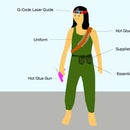Introduction: Lazy Knit Sweater
Love custom knits but feel short on time? I do and am! I bought a punch card knitting machine a few years ago only to realize how hard it is to make an entire sweater. I ended up just playing with the punch card settings and making a bunch of patterned scarves. Yet, the vision of cool hand-made knit sweaters never left my mind and, sadly, the scarves were a bit too itchy to wear. My solution: buy a cheap knit sweater and sew a patch from the scarves onto the sweater. It's kind of like a graphic T-shirt, but with knits.
Here's what you'll need:
knit sweater
another other knit garment (sweater, scarf, etc) that you feel like cutting up
sharp pair of scissors
sewing supplies
Step 1: Find Some Knits That Need New Life
I had this scarf that I made which had great patterns but the wool felt awful on my skin. I also had a sweater that I thought could use some new life.
Step 2: Cut Your Materials
I started by laying the scarf over the sweater and eye-balling about how big I wanted the patch. I always start by cutting something a little bigger than I think since you can always cut away, but it's harder to put it back together. In this project, the direction of the knit is up to you and feel free to leave the edges raw or finish them off if you like that better.
I put on the sweater and mark with pins where I want the top and sides of the patch to be. To make sure things are centered. I fold the sweater in half and mark a pin on the crease. Then I fold the patch in half and mark a pin on it's crease. When I place the patch on the sweater, I make sure that my center crease pins are aligned. I pin the patch to the sweater and I fold it in half one more time to see if the edges of my patch line up with each other, further proof of being centered. If things don't line up, trim away extra material until they do or just leave it be, who says things need to always be straight and centered all the time?
Step 3: Sew!
For my first attempt, I cut a hole for the patch and used an serger sewing machine to sew the patch in. I used a serger because I wanted the edges of the knits to be bound so as not to unravel. This was overkill because the knife on my overlock cut the sweater to shreds. However, this "overkill" was a kind of happy accident since I ended up liking the messy, deconstructed look that came out of it. The image shows the inside of the sweater with the raw edges showing. Depending on your personal aesthetic, you may want to make these seams visible. It's up to you.
Also, I made the error of using a wool knit patch on a synthetic sweater which made my sweater morph in the dryer. A happy accident as I kind of like the messy marled look. Surprisingly enough, given all of the battle scars of this sweater, I still get compliments on it all the time.
Step 4: Do It Again!
I made my daughter a sweater with the same technique. Instead of cutting a hole in the sweatshirt and patching the knit in, I just used a zig zag stitch to attach it on top. Again, when it went in the dryer this caused some chaos (something that you can avoid by a. not drying it in a dryer and/or b. using synthetic or cotton knits). But, lo and behold, another happy accident. When I look inside this sweater, the shrinking of the wool creates this really cool ruched pattern on the inside. I plan on using this technique to artificially implant some texture into a tired old t-shirt one of these days.
The key to the sew-on-top technique is to use a stitch length that's fairly short. That way, when the edges of your knit patch start to unravel, the center of the patch will remain intact.
Step 5: Otra Vez!
This technique worked great when I found a cool light grey velour onesie at a second-hand shop for my little girl that had an annoying "baby boy" embroidery right in the center and that she happened to be too tall to wear. So, I cut off the bottom half of the onesie and turned it into a sweater (it snaps up the back). To hide the "baby boy" embroidery, I cut out another old knit scarf, this time in the shape of a triangle, and sewed it on top of the sweater. I used a bit of puffy paint to add her initial to the sweater since I kind of like the shape of the letter "M" and the contrast it forms with the triangle.
Ever since I've adopted this technique, I've been hunting through thrift stores for old knit sweaters with great patterns but are otherwise undesirable features. I'm building a small stockpile to repurpose into graphic sweaters and to inspire new ideas....more to come...













